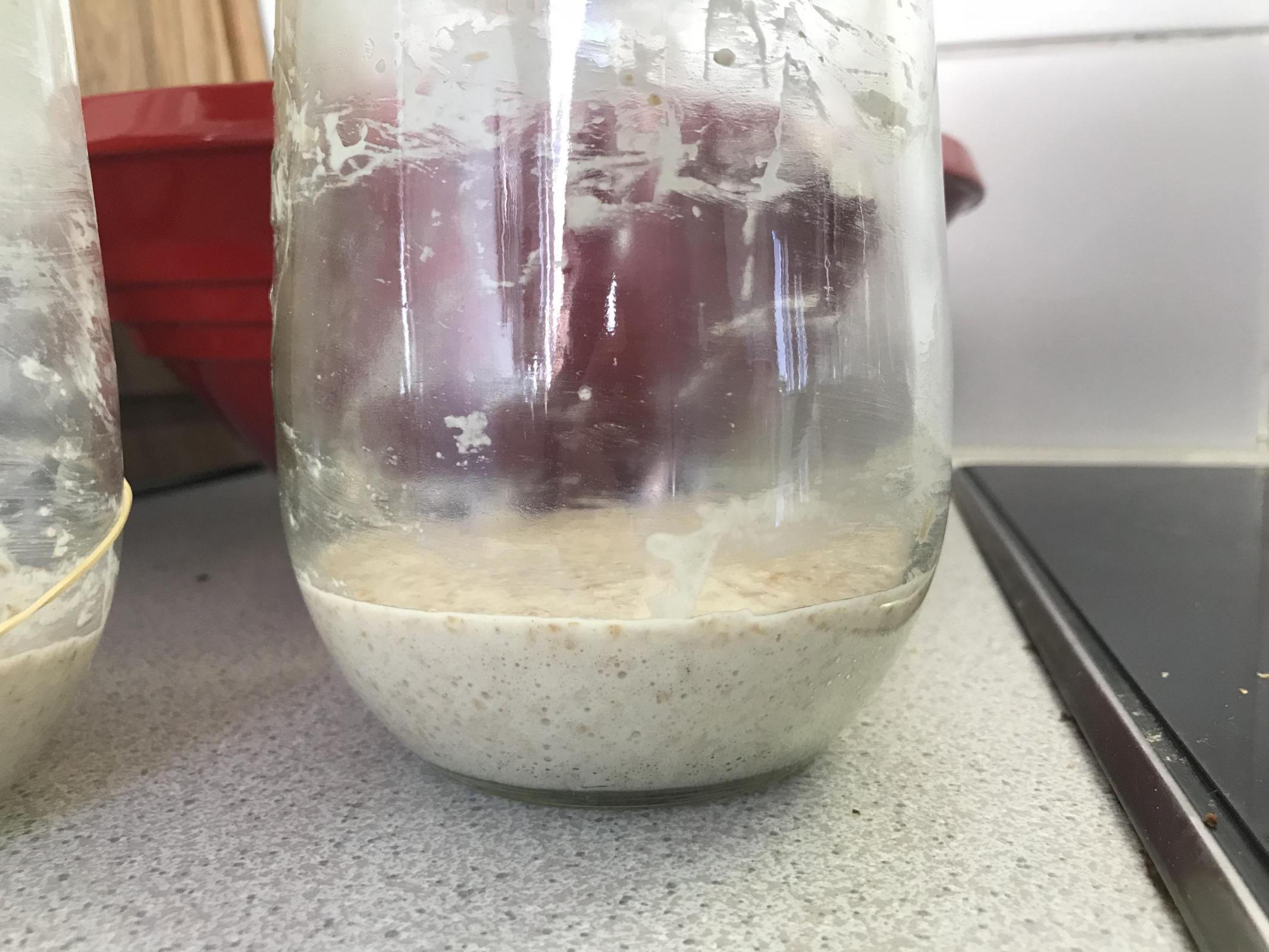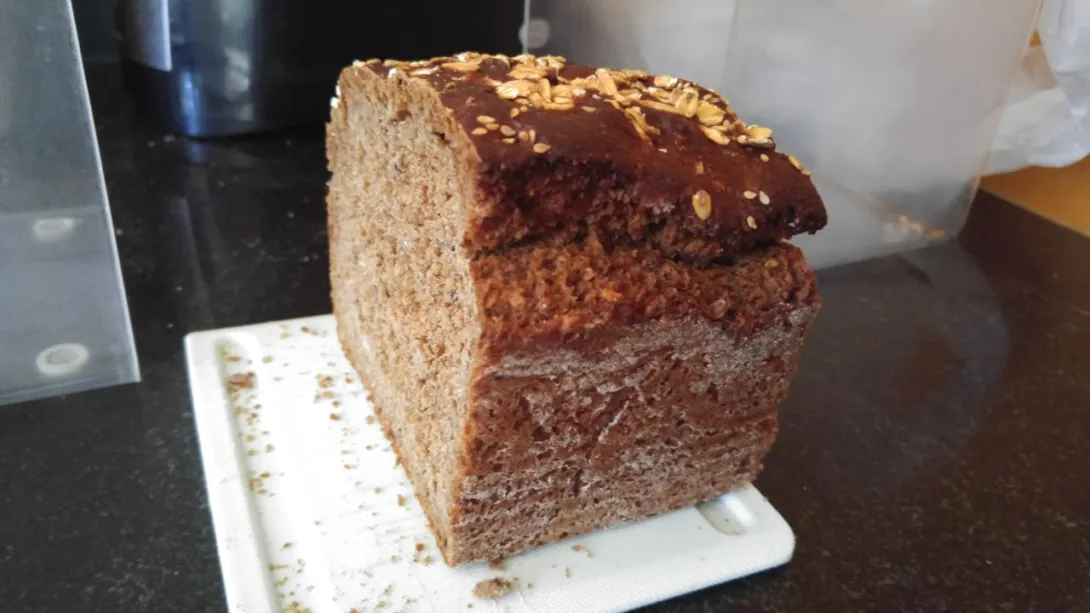Hi
I am having a problem figuring out when my sourdough is ready. Based on all the recipies i've read, it says to build the levain 12 hours or the day before you want to bake. Well, my starter (50/50 of WW and AP) only rises about 2 inches everytime i feed it and it happens in about 1-2 hours after the feeding. My feeding ratio is 1:1 in flour and water. I dont discard everytime, if i feel like building it up i just add flour and water and discard the next time or whenever i feel like i have too much.
I think i read on TFL that if i feed around 20 grams of starter a larger amount lets say 1:4:4, it would take longer and probably fit the 12 hour schedule. I mean i am totally fine with only 3-4 hours because then i can just make it early in the morning but is it normal for it to not rise that much?
And also another "problem" if you can say so is that it is very thin for a 1:1 starter. I can easily pour it out rather than scooping.
Hope someone can answer at least some of my problems. Thanks!!
Hi Badgermanden,
When you say you use a 1:1 ratio, do you mean by volume or weight? I have had success keeping my starter at 100% hydration; that means using a 1:1 ratio by weight. The fact that you can pour your starter suggests that you are using volume.
Sharon
i always use weight. Can there be any other reason? I use 100 grams of water to 100 grams of flour. Should I decrease my flour?
But what is the starter to feeding ratio?
If you maintain your starter by feeding 100g of starter with 20g water + 20g flour (for example only) and with each subsequent feeding you add a bit more water and flour then each time then you are building up a lot of spent starter. It'll be overly fermented and broken down. The yeasts will be low and the acidity high. It will also get more and more watery!
Take a little of your starter and start feeding with greater ratios of fresh water + flour and the yeast population will increase, the acidity will be more balanced, it'll rise more and be less liquid. A healthy starter.
But when you start doing this do so gradually! It might take a little while to gain in strength. You might begin with a 1:1:1 feed. allow that to fully mature however long it takes. Then proceed with a 1:2:2 (with discarding some otherwise you'll be building too much before long) etc.
I got to admt... I’ve been a bit everywhere with my feeding ratios... first I fed around 30-50 grams of starter with 1:1:1 and then I tried 1:2:2 and then I got a tip to just start with around 1 tbsp of starter and add 1-2 tbsp of water and flour each day to build up. So yeah maybe i should stick with one thing. I think I’m gonna empty it all except 30 grams tonight and then what do you recommend? 100 grams of flour and 100 of water?
Don't discard the discard just yet. Refrigerate it and have it as back up!
How about...
20g starter + 20g water + 20g flour
If all goes well then there's no need to keep the refrigerated discard.
Once this has matured take off 40g starter (keep it till the next feed) and feed the remaining 20g starter like so...
20 : 40 : 40
Then with the next feed...
20 : 60 : 60
And so on. You can even keep the discard each time and add it to the previous discard. You can make something with it
Carry on till you get to...
20 : 100 : 100
Once that has gone well you've got it back to a healthy starter. Then start to think of a manageable maintenance schedule.
Follow his instructions and if possible post images of your progress. Pictures can be extremely helpful.
Have you ever successfully baked bread with this starter? How old is it? What temperature is the area where your starter is kept?
Just in case you don’t understand our feeding directions. When you read feed the starter 1:1:1. That means 1 part starter + 1 part water + 1 part flour. So, if you wanted to keep 60 grams of starter you would feed 20g starter + 20g water + 20g flour.
You will have to remove some of your starter when feeding most of the time. It’s something most of us had to get used to. If you don’t your starter will quickly grow too large.
If you wanted to feed more heavily and keep your starter @ 100% hydration, say 3 to 1 (flour to starter), it would be 1:3:3.
I apologize if you already knew this. But I wanted to make sure we were communicating properly.
Dan
There is also a lot of good information out there about "washing" your starter.
I feed at 100% as well, usually 35g (roughly 1/4c). But every now and then I have to jump start it.
I use warm pineapple juice (not from concentrate), as previously covered here by Debra Wink and others, with the same ratio and weights.
http://www.thefreshloaf.com/node/10856/pineapple-juice-solution-part-1
Metro, once your starter becomes viable, I don’t think pineapple juice is needed. I say this because once the starter is up and working the bad bacteria that the juice drives off can no longer survive because the LAB (good bacteria) won’t allow any bad bacteria to live. The pineapple juice temporarily makes the new starter acidic. The bad bacteria can’t survive in an acid environment so they die. But after the bad bacteria die the LAB (good bacteria) multiply and bring with them acid that makes the starter healthy and wards off the bad stuff.
I thought this might be of interest to you.
QUESTION - what is happening to your starter that makes it need a “jump start”?
Dan
Try to feed with warmer water. Sourdough works faster at 26-28ºC.
Thanks for all the replies, im currently doing what Lechem told me even though i was planning on baking today. Here is some pictures. This is from my WW/AP sourdough around 10 hours after feeding.

Recently fed starter with 20 grams of starter + 20 grams flour + 20 grams of water (actually the picture is 20 grams + 40 + 40, because i started it yesterday and i do 12 hour feedings. I was planning to bake today, and the starter always floats after 3 hours or so - can i use it then?
Sorry i cant seem to figure out the image system on TFL but yeah this is still the new 1:2:2 starter
Watch the starter and not the clock. Don't refeed till it has matured each time. Bigger feeds and allowing it to mature fully each time will help increase the yeast population. How much has your starter grown? What does it smell like?
There is no hurry when doing this.
I think you should bake with the discard once it has matured fully but try doing a hybrid bread by adding into the dough a pinch or two of dried yeast.
This is going to take a a day or two or even three.
@Dan. It jumped using the method I describe, for better or worse. But it's doing well.
Made one loaf with it so far and noted the wights I used to try to plug into your sheet for next time.
Because of the amount of "other" flours, (as I believe you pointed out) the rise is some what hard to predict.
The finger poke test is not reliable. The result is tasty but may look a little intergalactic from loaf to loaf.
Last time I added 1/2 tsp yeast and thought the loaf had risen enough. But alas, a split loaf resulted.
I now feed the starter and put it in a cooler with a bowl of bowled water to move it along. Better than fogging an expensive to repair oven.
Years ago, I made an organic Silverton grape starter (wine grapes from here on LI). It was 100% reliable every time, and needed no additional yeast. But there was a long period of disuse and I couldn't revive it, or was too impatient.
I still have not gotten the hang of a flour & water starter as compared to the grape one. It was magic.
Metro, can you post images? It would be a great help.
also, if you take a screenshot of your spreadsheet, I’ll take a look.
Dan
here's the recipe:
7 mins on 3 in a Bosch Concept
7 more mins in the Concept, with 2.5 tsp salt and 1/2 tsp yeast.
didn't take snaps of the last dough, but it looked very nice, not to wet or dry. smooth. away from the sides of the bowl.
Let it rise on the counter top about an hour. Room temp was prolly around 65º F.
This was the result. Still tasty as I said, but I'd guess under proofed.
Image

With no yeast, it ends up a brick.
From what I can see, the breads looks good. How much yeast did you use?
Next time if to make a shallow slice on the top of the dough, it shouldn’t crack (split) like the one in your image.
Looks like a great bake!
Dan
1/2 tsp. I always make 3 cuts in a loaf like this. Very variable loaves. Some look great, some split.